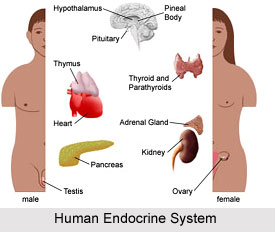 The Endocrine system consists of different glands which releases secretions directly into the blood stream. These secretions, known as hormones, circulate all over the body and help in the control of various activities. Just like the nervous system, it communicates, controls and integrates the functions all over the body, but with some difference. The nerve impulse produces rapid short lasting responses but the hormones produce slower and generally long lasting response. The nerve impulse can influence only the muscle cells and gland cells while hormones influence all kinds of cells. Nerves can get fatigued more easily and are unsuitable for protracted stimulation. Where organs are to be governed for long period, it is much effective and easier to govern them through chemical means i.e. hormones.
The Endocrine system consists of different glands which releases secretions directly into the blood stream. These secretions, known as hormones, circulate all over the body and help in the control of various activities. Just like the nervous system, it communicates, controls and integrates the functions all over the body, but with some difference. The nerve impulse produces rapid short lasting responses but the hormones produce slower and generally long lasting response. The nerve impulse can influence only the muscle cells and gland cells while hormones influence all kinds of cells. Nerves can get fatigued more easily and are unsuitable for protracted stimulation. Where organs are to be governed for long period, it is much effective and easier to govern them through chemical means i.e. hormones.
The pituitary gland produces various hormones which influence and regulate the activity of the other endocrine glands viz. Thyroid, Para-Thyroid, Adrenal, Pancreas, Ovaries in female and Testis in male. In return this pituitary gland is intimately connected through the hypothalamus with the limbic system or the emotional brain. This inter-linking of the endocrine and the nervous system ultimately integrates all the functions of the human body in one composite force. Whether it is conscious or unconscious, volitional or the vegetative, rapidly changing or enduring, all these activities in the human body are integrated in one whole, through these neuro-endocrine systems.
 The ancient sages and different books on Yoga by them depict that yoga helps immensely to improve the functioning of endocrine glands. Yogas like Nabhiyasana, Sirshasana, Sarvangasana and Mayurasana are prescribed to cure the imbalance of endocrinal system. These asanas have direct effect on the pituitary gland, parathyroid glands, thyroid glands, pancreatic and adrenal glands.
The ancient sages and different books on Yoga by them depict that yoga helps immensely to improve the functioning of endocrine glands. Yogas like Nabhiyasana, Sirshasana, Sarvangasana and Mayurasana are prescribed to cure the imbalance of endocrinal system. These asanas have direct effect on the pituitary gland, parathyroid glands, thyroid glands, pancreatic and adrenal glands.
This article is a stub. You can enrich by adding more information to it. Send your Write Up to content@indianetzone.com




















